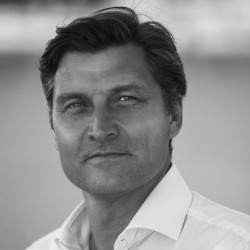Challenges of Nordic utilities and electricity sales companies

Energy transformation has had a major impact on current and future competitiveness for Nordic utilities and electricity wholesale companies. Uncertainty is high, and long-term strategy is high up the agenda. Fredrik Bodecker has led several strategy assignments for these companies and describes in this interview some of his conclusions, insights and forecasts. First published in our June-20 report.
Why is long-term strategy high up on the agenda now?
Technology development is accelerating. It is digitized, non-linear (rather exponential), and global. We humans, shaped by hundreds of thousands, maybe millions of years in a linear world, find it challenging to grasp the scale and speed. The rapid expansion of wind power in Sweden and Norway, for example, has taken most players with surprise and substantially affects grid companies, producers, and early investors.
The new energy landscape with variable, renewable, and distributed production, as well as digitalisation is challenging the traditional energy companies. At the local level, the electricity market hub, the "sales-centric model" (if still to be implemented?), The Nordic balancing concept, and the aggregator model require adaptation to new regulation and competitors. It will force all traditional companies to rethink their business strategies.
"Risk for disruption of traditional electricity sales model increase every quarter"
We have seen increased political and social pressure for the transition to renewables. The risk of "disruption " of the traditional electricity sales model is higher each quarter due to new flexibility solutions, digitalisation, AI, internet-of-things, competitive battery storage solutions, electric cars, and their ecosystems, blockchain technology, and lower thresholds for new entrants and changing consumer attitudes.
"Those protected behind the inertia of regulations will meet difficulties"
This creates uncertainty regarding which technology, which business models, and which potential partners will end up on the winning side. A significant risk, especially from the established companies' point of view, is that regulations are not up to speed with technology development resulting in even faster and involuntary market changes. Those who are protected behind the inertia of these regulations will find it extremely difficult with the new requirements of speed and flexibility.
In summary, significantly higher competition from new players with new technology and new business models. This must be taken seriously and handled with a review of own strategies.
Which are the most significant concerns of power producers?
For Power&Heat built over the last decade, it is the electricity certificate pride crash. Many budgets in these huge investments include certificate prices as high as 350 SEK! Some have used 150 SEK as a "worst-case". Current levels mean income losses of many hundred million SEK over the fifteen years budgeted for. Since this is a loss of income, it does not as visible as a pure loss, but it is still a hole that must be filled by other income.
"Paradigm shift for Power&Heat"
Of course, the currently meager power prices are also a significant challenge. This winter was exceptional with the strong hydro balance, but I think we have a new paradigm coming; The co-generation, usually provided with an extra possible "upside" from high winter power prices, will from now on face competition from the enormous build-out of wind power – also with the highest production in the same period. As our colleague usually says, "Summer is the new Winter!"
Which are the most significant concerns of electricity sales/trading companies?
For these companies, much has to do with increased requirements for regulatory compliance and collaterals, which has made it almost impossible for smaller players to trade and manage their price hedging in the financial markets or bilaterally. This is also noticeable in the disastrous liquidity on Nasdaq.
"Dark clouds in price area differences"
I also see two dark clouds in the form of price area differences and corporate PPAs. Substantial differences between, for example, southern and northern Sweden, will result in expensive hedging of price. The liquidity in hedging instruments for price areas (EPADs) is poor. The idea with the price areas was to give the national grid operators a clear signal to remove the bottlenecks. Of course, this takes time, but why this long? It did not take long for the decision to pay Ringhals 1 300 million SEK to be available during summer…
Corporate PPAs are useful for enabling renewable investments. They provide banks and financiers with the necessary security and are very beneficial for the power market. However, they also result in electricity buyers disappearing from the open, transparent markets, especially further out in time where there are too few market actors to provide relevant price signals. When fewer large consumers act on the open markets and instead purchase power directly from the wind farms in ten-year contracts, power trading will be pushed even more towards the front quarters and year.
Anything else to add?
With the new legislative proposals and the clear intention of the EU's winter package to open up to external aggregators, grid companies will face significant constraints at the same time as they will meet new challenges with lots of resources and excellent innovation power.
However, this does not prevent existing grid companies from "reinventing themselves" and their role [as aggregators]. Maybe this external threat is necessary? It is not easy to create an innovative culture in a natural monopoly, and this may rather provide a vitamin injection. My experience is that new players underestimate the complexity of the electricity market.
Do you see any new trends? New technologies that will make a big impact?
I think we underestimate how quickly battery storage will affect the markets. Most reports indicate years 2030-2040, but with current cost reduction trends, all parallel research projects, and not least the opportunities within the Nordic Balance Concept and the aggregator model, I believe we will have plannable power production from our wind and solar parks before 2030.
"New dynamic when hydropower and wind + battery must fight with consumer aggregators for the highest price"
I look forward to the momentum when the hydro producers, wind-plus-battery producers, and the aggregators with consumption flexibility are going to fight for who manages to get the highest price for their supply. The long-term forecasts we are using stretch until 2040 or 2050. In over 15 years, we may even have fourth generation of nuclear power as a joker in the game (a wish from the engineer within).
Which new competitors do you see coming?
The aggregator model will be interesting to follow. Will it be the traditional companies developing, or will new players with new technology and new business models enter? We have discussed for a long time that Google, Amazon etc. could become much more involved in the power markets, but we have not seen it yet. Like so many times before, perhaps a completely different type of player enters the scene. Tesla recently applied for permission to sell power in the UK.
The electric cars will provide massive battery capacity. Yet, no one seems to have found a model to exploit this, but this is a potential game-changer.
Are Nordic utilities ready to embrace needed adjustments?
There is a vast spectrum from those who throw themselves at new opportunities to those who rather stick to regulations to exploit current benefits for as long as possible. There is nothing wrong with that, as long as it is an active decision. There are high risks in choosing the wrong technology or the wrong partner for the uncertain changes awaiting. I have met several actors that I have advised to wait for and do nothing until we have more knowledge of new trends and technologies.
"Make an active decision - do not let others make them for you"
In almost 25 years in the industry, I have never seen so many changes come in such a short time and with such potentially huge consequences. No matter how you choose to handle this, my advice is to actively make that decision yourself - not let it be made for you.
About Bodecker Partners AB
Bodecker Partners’ expertise within Swedish electricity certificates and carbon emission rights, as well as the Nordic power market, is first-class. We offer independent advisory services to power producers and renewable energy investors in addition to tailored portfolio management services for electricity certificates and carbon emission rights.
Contacts



Gustaf Sundelius
- gustaf@bodeckerpartners.com
- +46 (0)708 796 968

Sevdie Denli
- sevdie@bodeckerpartners.com
- +46 (0)73 808 18 80